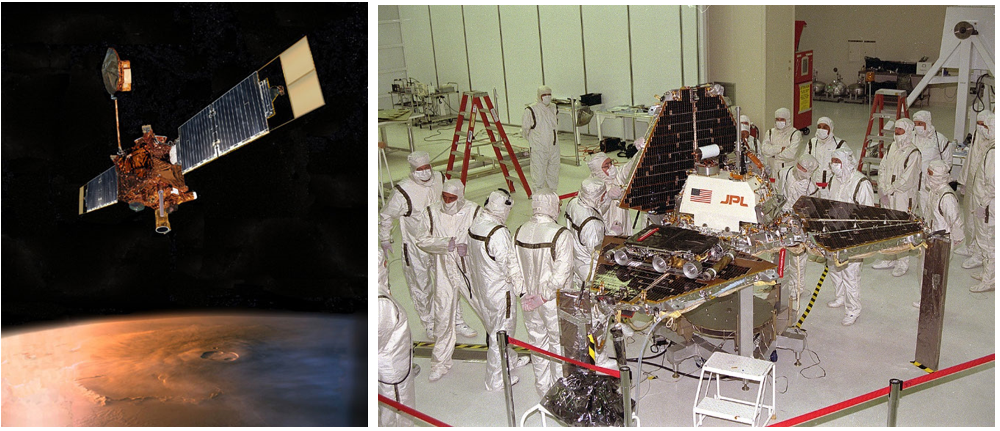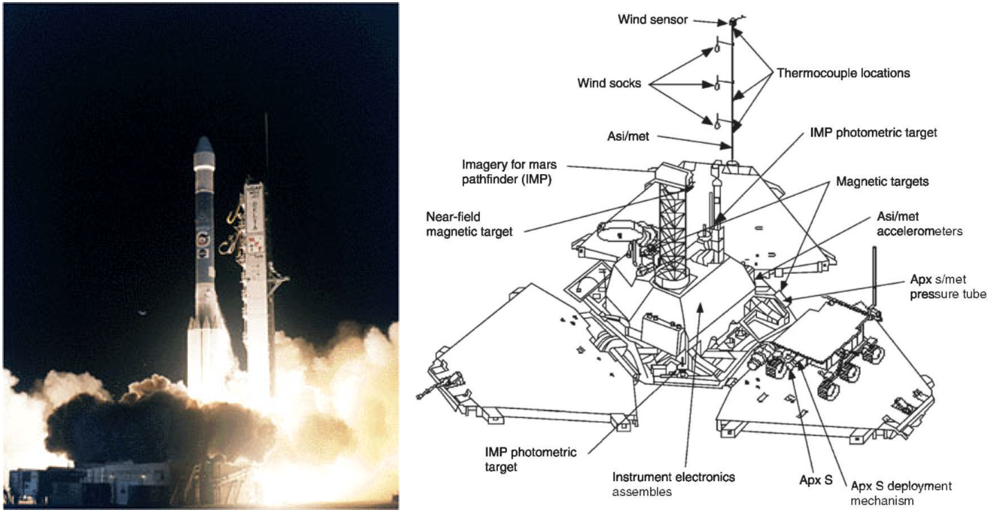25 Years Ago: Mars Pathfinder Launches to Mars to Deploy Sojourner, the First Planetary Rover
Mars has fascinated us for centuries. Through the middle of the 20th century, some scientists believed that Mars might be hospitable to some form of life, only to have those hopes seemingly dashed when the early robotic explorers of the 1960s found a Moon-like cratered terrain with a forbiddingly cold and thin atmosphere composed of carbon dioxide. More sophisticated orbiters and landers in the 1970s revealed evidence that water may have once flowed on Mars, but a search for signs of life proved inconclusive at best. Following the six years, between 1976 and 1982 when the Viking spacecraft operated on and in orbit around Mars, robotic exploration of Mars entered a nearly 15-year hiatus, with just a very brief break. The Soviet Fobos 2 probe entered orbit around Mars in January 1989, operating for only two months and not achieving its primary goal of placing a lander and a hopper onto Mars’ larger moon Phobos. In August 1993, the American Mars Observer spacecraft went silent just two days before entering orbit around Mars, likely falling victim to a fuel-line rupture that caused a catastrophic failure. The Mars Pathfinder began a new era of continuous robotic Mars exploration.

Left: Illustration of the Mars Global Surveyor spacecraft in orbit around Mars. Right: Ground crews prepare Mars Pathfinder with its Sojourner rover for launch. Credits: NASA
Favorable launch opportunities to Mars occur every 26 months and, during the late 1996 window, the United States dispatched two spacecraft to the Red Planet: an orbiter called Mars Global Surveyor (MGS) and Mars Pathfinder, a lander that deployed the first rover on Mars. The Jet Propulsion Laboratory (JPL) in Pasadena, California, managed both spacecraft for NASA. The landing of Mars Pathfinder and its Sojourner rover on July 4, 1997, began an uninterrupted period with at least one spacecraft and typically several operating in Martian orbit or on the planet’s surface. This nearly-quarter century of continuous scientific observation is unmatched anywhere else in the solar system — except on Earth. The 793-pound Mars Pathfinder deployed the 23-pound Sojourner rover, the first wheeled vehicle operated on another planet in the solar system, which served as the forerunner of later, more advanced rovers such as Curiosity and Perseverance, currently operating on the Martian surface. NASA chose to name the rover after Sojourner Truth, an African American reformist of the Civil War era, inspired by the winning essay submitted by 12-year-old Valerie Ambrose of Bridgeport, Connecticut, thanks to a naming contest organized by JPL and The Planetary Society.

Left: Launch of Mars Pathfinder on Dec. 4, 1996. Right: Schematic of the Mars Pathfinder lander and the Sojourner rover showing their major components and scientific instruments. Credits: NASA
The launch of Mars Pathfinder on a Delta rocket took place on Dec. 4, 1996, from Launch Complex 17B at Cape Canaveral Air Force Station in Florida (now Cape Canaveral Space Force Station). Four mid-course corrections refined the spacecraft’s trajectory during its 212-day interplanetary cruise. Although it launched after MGS, Pathfinder arrived at Mars on a faster trajectory — more than two months earlier. The lander was expected to operate for one month, and the rover for one week. For its exploration of the Red Planet’s surface, the Pathfinder and Sojourner together carried four instruments, including:
- Mars Pathfinder lander
The mast-mounted imager for Mars Pathfinder, including a stereoscopic color camera, a magnetometer for magnetic field measurements, and an anemometer for recording winds; and the Atmospheric Structure Instrument/Meteorology package to determine the temperature and density of the atmosphere during the entry, descent, and landing, and to take daily weather measurements once on the surface. - Sojourner rover
The Alpha-Proton X-ray Spectrometer to determine the dominant elements of the rocks and other surface materials at the landing site; and the three-camera imaging system consisting of two black-and-white and one-color camera.

Left: Illustration of Mars Pathfinder’s descent, entry, and landing profile, including NASA’s first use of landing airbags. Right: The general area of Mars Pathfinder’s landing site in Ares Vallis, taken by Mars Global Surveyor in April 1998. Credits: NASA
Upon arrival at Mars on July 4, 1997, Mars Pathfinder began its four-minute entry, descent, and landing sequence — the first U.S. spacecraft to use the approach of using landing air bags. The spacecraft entered the Martian atmosphere at 14,000 mph, protected inside an aeroshell derived from the Viking landers’ design. The aeroshell slowed the spacecraft’s velocity to 830 mph, allowing the deployment of a supersonic parachute that further slowed the craft to 150 mph. The spacecraft then released the forward heat shield, remaining attached to the back shell by a 66-foot tether. At an altitude of one mile, it activated its radar altimeter that precisely timed the next events. At 1,165 feet above the surface, airbags surrounding the spacecraft inflated in less than one second and, at 322 feet, three solid retrorockets fired to further slow the descent. At 71 feet above the ground, Pathfinder, still cocooned in its airbags, cut itself free and fell to the surface, impacting at 31 mph and bouncing 15 times before finally coming to rest. After 87 minutes, the airbags deflated and the spacecraft opened like the petals of a flower, exposing its solar arrays, instruments, and the Sojourner rover, still in its stowed position. Following the landing in the Ares Vallis (Valley of Mars), an ancient flood plain in Mars’ northern hemisphere, Mars Pathfinder was redesignated the Carl Sagan Memorial Station after the late noted astronomer and planetologist.

Left: Image of the Sojourner rover sitting on the Mars Pathfinder lander prior to its deployment to the surface. Right: Image of the Mars Pathfinder lander taken by the Sojourner rover shortly after it deployed to the surface. Credits: NASA
During its first full day on the Martian surface, Mars Pathfinder took photographs of its surroundings and completed its first weather recordings. The next day, July 6, Sojourner “stood up” on its six wheels and backed down one of the lander’s two ramps onto the surface, becoming the first wheeled vehicle operated on another planet. By the next day, Sojourner began exploring and analyzing some of the nearby rocks for their composition. Controllers nicknamed notable rocks after cartoon characters, such as Barnacle Bill, Yogi, and Scooby Doo.

Panoramic view of Mars Pathfinder’s landing site, with the Sojourner rover at center, sampling the rock nicknamed Yogi. Credits: NASA

Left: Two modest-sized hills, dubbed Twin Peaks by scientists, to the southwest of Pathfinder’s landing site. Right: The Sojourner rover sampling the rock that scientists nicknamed Yogi. Credits: NASA
For 83 days, 12 times longer than its anticipated one-week operational lifetime, Sojourner explored the area around the landing site, traveling at a maximum speed of 0.39 inches per second, its movements controlled by engineers at JPL. Overall, the rover traveled a total distance of 330 feet, never venturing more than 39 feet from the Pathfinder lander. It sampled the chemical properties of rocks and soil at 16 different locations near the lander and found that they generally resembled volcanic rocks on Earth.

Left: Clouds, most likely composed of ice crystals, seen during a Martian sunrise by Mars Pathfinder. Middle: Sunset on Mars as seen by Mars Pathfinder. Right: Image of Mars Pathfinder on the surface of Mars as seen from orbit by Mars Reconnaissance Orbiter in 2006. Credits: NASA
During operations, Sojourner returned 550 photographs and Mars Pathfinder 16,500 photographs, not only of the surface but also of clouds and sunsets. In addition, the lander completed 8.5 million measurements of Martian weather, including atmospheric pressure, temperature, and wind speed. Contact was unexpectedly lost with Pathfinder and Sojourner on Sept. 27, 1997, for unknown reasons. Both far exceeded their operational life expectancies and vastly increased our knowledge of Mars. The technologies used in both Mars Pathfinder and Sojourner enabled more sophisticated spacecraft to continue the exploration of Mars in the 21st century.
With special thanks to JPL Historian Erik Conway.







